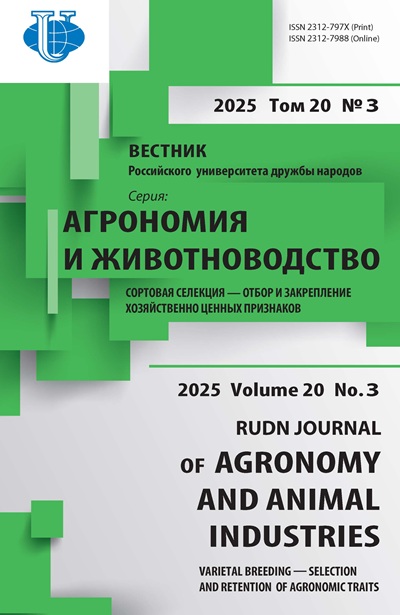Изучение особенностей водного режима и пылеудерживающей способности культур Betula pendula Roth. в Северном Казахстане
- Авторы: Кабанов А.Н.1, Кабанова С.А.1, Данченко М.А.2, Кочегаров И.С.1
-
Учреждения:
- Казахский научно-исследовательский институт лесного хозяйства и агролесомелиорации
- Томский государственный университет
- Выпуск: Том 15, № 4 (2020)
- Страницы: 325-334
- Раздел: Растениеводство
- URL: https://agrojournal.rudn.ru/agronomy/article/view/19600
- DOI: https://doi.org/10.22363/2312-797X-2020-15-4-325-334
- ID: 19600
Цитировать
Полный текст
Аннотация
Цель исследований - определение водного режима и выявление характера пылеудерживающей способности ассимиляционного аппарата искусственных березовых насаждений в зеленой зоне г. Нур-Султана (Северный Казахстан). Объект исследований - 16-летние лесные культуры Betula pendula Roth., часть которых была пересажена в 8-летнем возрасте в межкулисное пространство. Рассмотрены некоторые особенности водного режима лесных культур для определения адаптационной способности к почвенно-климатическим условиям произрастания. Изучены интенсивность транспирации листьев, относительное содержание воды в листьях, уровень водного дефицита. При выполнении наблюдений установлено, что на пробных площадях в пересаженных и непересаженных культурах нет достоверного различия между показателями водного режима, поэтому результаты исследований приведены без учета особенностей места закладки пробных площадей. Выявлена высокая водоудерживающая способность листьев рассматриваемых культур, которая составила 96,98 %. Интенсивность транспирации в среднем за вегетационный период была в пределах 176 мг/г∙ч, при этом наибольший средний показатель интенсивности транспирации (229 мг/г∙ч) выявлен в июле, наименьший - в августе (162 мг/г ∙ ч). Сделан вывод о слабой интенсивности испарения влаги листьями, что говорит о низком водном дефиците рассматриваемых культур, который составил 8,96 % при полном насыщении листа влагой. При определении соотношения осевшей пыли и площади листьев березы повислой установлено, что на единицу площади ассимиляционного аппарата (1 см2) в среднем по пробным площадям оседает 0,1 мг пыли. При определении количества осевшей пыли выявлено, что на высоком местоположении на единицу площади ассимиляционного аппарата оседает пыли больше, чем на низком. Наибольшее количество пыли (0,117 мг/см2) осаживалось на отдаленности в 1000 м от автомагистрали, наименьшее (0,091 мг/см2) - на расстоянии 200 м. На данный факт повлияли особенности рельефа местности и наличие защитной полосы перед культурами березы. При проведении исследований установлено, что большая площадь листа не является гарантией лучшей пылеудерживающей способности.
Ключевые слова
Об авторах
Андрей Николаевич Кабанов
Казахский научно-исследовательский институт лесного хозяйства и агролесомелиорации
Автор, ответственный за переписку.
Email: ankabn@mail.ru
магистр экологии, научный сотрудник отдела воспроизводства лесов и лесоразведения
Казахстан, 021704, Акмолинская обл., г. Щучинск, ул. Кирова, д. 58Светлана Анатольевна Кабанова
Казахский научно-исследовательский институт лесного хозяйства и агролесомелиорации
Email: Kabanova.05@mail.ru
кандидат биологических наук, зав. отделом воспроизводства лесов и лесоразведения
Казахстан, 021704, Акмолинская обл., г. Щучинск, ул. Кирова, д. 58Матвей Анатольевич Данченко
Томский государственный университет
Email: mtd2005@sibmail.com
кандидат географических наук, доцент кафедры лесного хозяйства и ландшафтного строительства, Биологический институт
Российская Федерация, 634050, г. Томск, ул. Ленина, д. 36Игорь Сергеевич Кочегаров
Казахский научно-исследовательский институт лесного хозяйства и агролесомелиорации
Email: garik_0188@mail.ru
младший научный сотрудник отдела воспроизводства лесов и лесоразведения
Казахстан, 021704, Акмолинская обл., г. Щучинск, ул. Кирова, д. 58Список литературы
- Беляева Ю.В. Показатели флуктуирующей асимметрии Betula pendula Roth., в условиях антропогенного воздействия (на примере г.о. Тольятти) // Известия Самарского НЦ РАН. 2013. Т. 15. № 3 (7). С. 2196-2200.
- Булыгин Н.Е., Ярмишко В.Т. Дендрология. М. : МГУЛ, 2003. 528 с.
- Татарникова В.Ю., Дашиева О. Древесные растения и городская среда // Актуальные проблемы лесного комплекса. 2009. № 23. С. 191-194.
- Lutter R., Tullus A., Kanal A., Tullus Т., Vares A., Tullus H. Growth development and plant-soil relations in midterm silver birch (Betula pendula Roth.) plantations on previous agricultural lands in hemiboreal Estonia // European Journal of Forest Research. 2015. № 134(4). P. 653-667. doi: 10.1007/s10342-015-0879-x
- Daugaviete M., Korica A.M., Silins I., Barsevskis A., Bardulis A., Bardule A., Spalvis K., Daugavietis M. The use of mineral nutrients for biomass production by young birch stands and stands vitality in different forest growing conditions // Journal of Environmental Science and Engineering. 2015. B 4. P. 177-189. doi: 10.17265/2162-5263/2015.04.002
- Сенькина С.Н. Водный потенциал ассимиляционного аппарата хвойных, как мера активности и состояния воды в растении // Вестник ИБ КОМИ НЦ УрО РАН. 2018. № 1 (203). С. 39-44.
- Беляева Ю.В. Результаты исследования водоудерживающей способности листовых пластинок Betula pendula Roth., произрастающей в условиях антропогенного воздействия (на примере г. Тольятти) // Изв. Самар. НЦ РАН. 2014. Т. 16. № 5 (5). С. 1654-1659.
- Сергейчик С.А. Газопоглотительная способность растений и аккумулирование в них элементов промышленных загрязнений // Оптимизация окружающей среды средствами озеленения. Минск : Наука и техника, 1985. С. 68-75.
- Данченко М.А. Система лесоводственных мероприятий по повышению рекреационной емкости и устойчивости городских лесов // Вестник Томского государственного университета. 2011. № 347. С. 156-158.
- Кабанова С.А., Нысанбаев Е.Н., Данченко М.А., Кабанов А.Н. Итоги опытно-производственных работ по пересадке деревьев в межкулисные пространства и введению хвойных интродуцентов в зеленой зоне г. Астаны // Успехи современного естествознания. 2016. № 9. С. 56-61.
- Погода и климат. Режим доступа: http://www.pogodaiklimat.ru/climate/35188.htm
- Бюсген М. Строение и жизнь наших лесных деревьев. М. : Гослесбумиздат, 1961. 424 с.
- Лир X., Польстер Г., Фидлер Г.И. Физиология древесных растений. М. : Лесная промышленность, 1974. 424 с.
- Кентбаева Б.А. Методология научных исследований. Алматы : Нур-Принт, 2014. 209 с.
- Иванов Л.А., Силина А.А., Цельникер Ю.Л. О методе быстрого взвешивания для определения транспирации в естественных условиях // Ботанический журнал. 1950. Т. 35. № 2. С. 171-185.
- Пахомова Г.И., Безуглов В.К. Водный режим растений. Казань : Изд-во Казан. ун-та, 1980. 249 с.
- Кавеленова Л.М. Проблемы организации системы фитомониторинга городской среды в условиях лесостепи. Самара : Универс групп, 2006. 223 с.
- Бессонова В.П. Эффективность осаждения пылевых частиц листьями древесных и кустарниковых растений // Вопросы защиты природной среды и охрана труда в промышленности. Днепропетровск : ДГУ, 1993. С. 34-37.
- Капелюш Н.В., Бессонова В.П. Пилоосаджуюча роль Platanus orientalis й Platanus acerifolia у насадженнях санітарно-гігієнічного призначення // Науковий вісник Чернівецького університету: Збірник наукових праць. Вип. 343: Біологія. 2007. С. 88-97.
Дополнительные файлы















